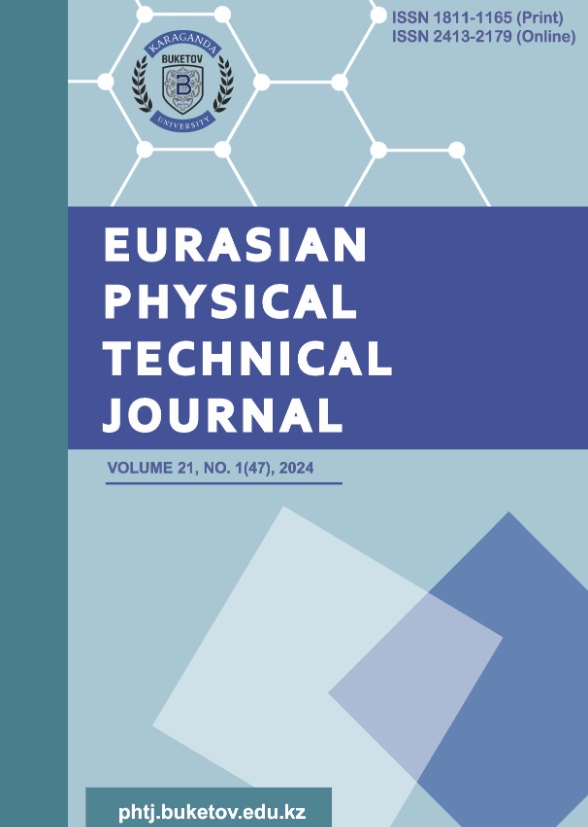NEW METAL/SUPERCONDUCTOR-INSULATOR TRANSITIONS AND THEIR EFFECTS ON HIGH-TC SUPERCONDUCTIVITY IN UNDERDOPED AND OPTIMALLY DOPED CUPRATES
DOI:
https://doi.org/10.31489/2024No1/21-27Keywords:
polaron formation and charge density waves, metal/superconductor-insulator transition, cuprates, Bose-liquid superconductivity, different disorders, suppression and enhancement of high-T superconductivityAbstract
A new approach to the metal/superconductor-insulator transition in doped cuprates by studying the polaron formation and localization of doped charge carriers (holes) in them and the possibility of transforming a metallic or superconducting system into an insulator was developed. A more suitable criterion for such a phase transition by comparing the bandwidth (or Fermi energy) of large polarons with their binding energies in the cuprates was derived. The possibility of the metal/superconductor-insulator transition and phase separation in doped cuprates resulting in the formation of competing metallic/superconducting and insulating phases in underdoped, optimally doped and even in overdoped high-Tc cuprates was predicted. Then the possible detrimental and beneficial effects of the different disorders (e.g. polaron formation and charge-density-wave transition) and the coexisting insulating and superconducting phases on the critical temperature of the superconducting transition of underdoped and optimally doped cuprates was examined. The actual superconducting transition temperature in these materials using the theory of Bose-liquid superconductivity, and not the Bardeen-Cooper-Schrieffer-like theory of Fermi-liquid superconductivity, which is incapable of predicting the relevant value of in high- cuprates was determined. We find that the suppressing of the polaronic and charge-density-wave effects in optimally doped cuprates results in the enhancement of , while some lattice defects (e.g., anion vacancies) in the cuprates may strongly affect, on and enhance high- superconductivity in them.
References
Imada M., Fujimori A., Tokura Y. Metal-insulator transitions. Review of Modern Physics, 1998, Vol.70, pp.1039. https://doi.org/10.1103/RevModPhys.70.1039
Dzhumanov S. Theory of Conventional and Unconventional Superconductivity in the High-T Cuprates and Other Systems. Nova science publishers, New York, USA, 2013, 356 p. https://novapublishers.com/shop/theory-of- conventional-and-unconventional-superconductivity-in-the-high-tc-cuprates-and-other-systems/
Dzhumanov S., Baimatov P.J., Ganiev O.K., Khudayberdiev Z.S., Turimov B.V. Possible mechanisms of carrier localization, metal–insulator transitions and stripe formation in inhomogeneous hole-doped cuprates. Journal of Physics and Chemistry of Solids, 2012, Vol.73(3), pp. 484 – 494. https://doi.org/10.1016/j.jpcs.2011.11.029
Lee P.A., Nagaosa N., Wen X.-G. Doping a Mott insulator: Physics of high-temperature superconductivity. Review of Modern Physics, 2006, Vol.78 (1), pp. 17 – 85. https://doi.org/10.1103/RevModPhys.78.17
Bardeen J., Cooper L.N., Schrieffer J.R. Theory of superconductivity. Physical Review, 1957, Vol.108 (5), pp.1175. https://doi.org/10.1103/PhysRev.108.1175
Lavrov A.N., Gandmakher V.F. Low-temperature resistivity of underdoped cuprates, Physics-Uspekhi, 1998, Vol.41(2), pp. 223-226. https://ufn.ru/ufn98/ufn98_2/ufn982ai.pdf
Goldman A.M., Markovic N. Superconductor‐Insulator Transitions in the Two‐Dimensional Limit. Physics Today, 1998, Vol.51(11), pp. 39 - 44. https://doi.org/10.1063/1.882069
Vedeneev S.I. High-temperature superconductors in high and ultrahigh magnetic fields. Physics-Uspekhi, 2012, Vol.55(6), pp. 625 – 632. https://doi.org/10.3367/UFNe.0182.201206h.0669
Ino A., Kim C., Nakamura M., Yoshida T., Mizokawa T., Shen Z.-X., Fujimori A., Kakeshita T., Eisaki H., Uchida S. Electronic structure of La2-xSrxCuO4 in the vicinity of the superconductor-insulator transition. Physical Review B, 2000, Vol.62, pp. 4137. https://doi.org/10.1103/PhysRevB.62.4137
Ono S., Ando Yoichi, Murayama T., Balakirev F.F., Betts J.B., Boebinger G.S. Metal-to-Insulator Crossover in the Low-Temperature Normal State of Bi2Sr2−xLaxCuO6+δ. Physical Review Letters, 2000, Vol. 85(3), pp. 638 – 641. https://doi.org/10.1103/PhysRevLett.85.638
Anshukova A.I., Golovashkin L.I., Ivanova A.P., Rusakov. J. The effect of superstructural ordering on the properties of high-temperature oxide superconductor systems. Journal of Experimental and Theoretical Physics, 2003, Vol.96(6), pp. 1045. https://doi.org/10.1134/1.1591216
Abrikosov A.A. Resonant tunneling in high-Tc superconductors. Physics-Uspekhi, 1998, Vol.41(6), pp. 605 - 616. https://doi.org/10.1070/PU1998v041n06ABEH000411
Kastner M.A., Birgeneau R.J., Shirane G., Endoh Y. Magnetic, transport, and optical properties of monolayer copper oxides. Review of Modern Physics, 1998, Vol.70(3), pp. 897 – 928. https://doi.org/10.1103/RevModPhys.70.897
Basov D.N., Timusk T. Electrodynamics of high-Tc superconductors. Review of Modern Physics, 2005, Vol.77(2), pp. 721 – 779. https://doi.org/10.1103/RevModPhys.77.721
Dzhumanov, S., Khidirov, I., Kurbanov, U. T., Khudayberdiev, Z. S., Rashidov, J. S. Distinctive Features of Metal-Insulator Transitions, Multiscale Phase Separation, and Related Effects in Hole-Doped Cuprates. Ukrainian Journal of Physics, 2019, Vol. 64(4), pp. 322. https://doi.org/10.15407/ujpe64.4.322
Dzhumanov S., Sabirov S.S., Karimbaev E.X., Rashidov J.Sh., Djumanov D.S., Kurbanov U.T., Sheraliev M.U. Formation of strong-coupling (bi)polarons and related in-gap states in lightly-doped cuprate superconductors. Modern Physics Letters B, 2021, Vol.35, pp. 2150190. https://dx.doi.org/10.1142/s0217984921501906
Bi X.X., Eklund P.C. Polaron contribution to the infrared optical response of La2−xSrxCuO4+δ and La2−xSrx . Physical Review Letter, 1993, Vol.70(17), pp. 2625 – 2628. https://doi.org/10.1103/PhysRevLett.70.2625
Fink J., Nucker N., Alexander M., Romberg H., Knupeer M., Merkel M., Adelmann P., Claessen R., Mante G., Buslaps T., Harm S., Manzke R., Skibowski M. High-energy spectroscopy studies of high-Tc superconductors. Physica C: Superconductivity, 1991, Vol.185–189 (1), pp. 45 – 50. https://doi.org/10.1016/0921-4534(91)91948-4
Ono S., Ando Y., Murayama T., Balakirev F.F., Betts J.B., Boebinger G.S. Low-temperature normal state of Bi2Sr2−xLaxCuO6+δ: comparison with La2−xSrxCuO4. Physica C: Superconductivity, 2001, Vol. 357–360 (1), pp. 138 – 141. https://doi.org/10.1016/S0921-4534(01)00187-3
Ando Y., Ono S., Sun X.F., Takeya J., Balakirev F.F., Betts J.B., and Boebinger G.S. Quantum Phase Transitions in the Cuprate Superconductor Bi2Sr2−xLaxCuO6+δ. Physical Review Letters, 2004, Vol. 92, pp. 247004. https://doi.org/10.1103/PhysRevLett.92.247004
Dzhumanov S. Microscopic theory of pseudogap phenomena and unconventional Bose-liquid superconductivity and superfluidity in high-Tc cuprates and other systems. arXiv:1912:12407, 2020, pp. 74. https://doi.org/10.48550/arXiv.1912.12407
Pietronero L., Strässler S and Grimaldi C., Nonadiabatic superconductivity. I. Vertex corrections for the electron-phonon interactions. Physical Review B, 1995, 52, 10516. https://doi.org/10.1103/PhysRevB.52.10516
Timusk T., Statt B. The pseudogap in high-temperature superconductors: an experimental survey. Rep. Prog. Phys., 1999, Vol.62, pp. 61. doi:0.1088/0034-4885/62/1/002
Matsuzaki T., Ido M., Momono N., Dipasupil R.M., Nagata T., Sakai A., Oda M. Superconducting gap and pseudogap behavior in high-Tc cuprates. J. Phys. Chem. Solids, 2001, Vol. 62, Is. 1-2, pp. 29-33. https://doi.org/10.1016/S0022-3697(00)00096-2
Tallon J.L., Loram J.W., Cooper J.R., Panagopoulos C., Bernhard C. Superfluid density in cuprate high-Tc superconductors: A new paradigm. Physical Review B, 2003, Vol. 68, pp. 180501. https://doi.org/10.1103/PhysRevB.68.180501
Leroux M., Mishra V., Ruff J.P.C., Claus H., Smylie M. P., Opagiste C., Rodiere P., Kayani A., Gu G. D., Tranquada J.M. Kwok W-K., Islam Z., Welp U. Disorder raises the critical temperature of a cuprate superconductor. Proceedings of the National Academy of Sciences- PNAS, 2019, Vol.116, pp. 10691. https://doi.org/10.1073/pnas.1817134116
Downloads
Published online
How to Cite
Issue
Section
License

This work is licensed under a Creative Commons Attribution-NonCommercial-NoDerivatives 4.0 International License.













